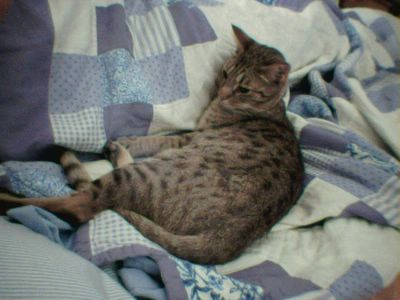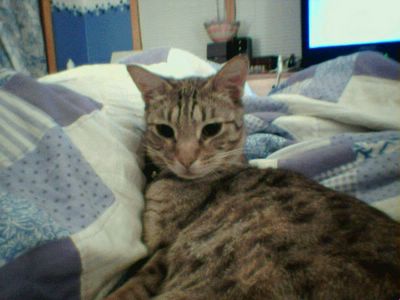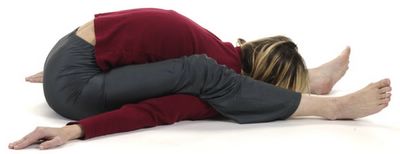Look At Your Cat, Then Try A Tortoise
Saturday was a sad day at our house. Rorey the ocicat succumed to a very strange cancer in his jaw. The visit to the vet was a real relief, but upsetting, too. Goodbye, Rorey.

Rorey, like most cats, knew how to relax.
Rorey was bred to look like an ocelot. He was a very cool looking cat.
I'll always remember Rorey as the cat my wife and daughter got while I was away from home. We were living in Virginia in 1998. I had come out to Missouri to live in my brother's guest room for six weeks and look for a job. While I was gone, our family expanded from 3 people and 1 dog, to 3 people, 1 dog and Rorey.
He's gone now. My second dog, Rommel, (we expanded some more) knows Rorey's gone and keeps looking for him to come home.

Rorey, the ocicat, in better days
Cats know how to stretch. Their most famous stretch is that back-rounding action you see at Halloween when the silhouette of the black cat is on decorations everywhere.

the cat's back
I am certain I did a cat pose, bidalasana, in my very first yoga class. It felt great then. It feels great today.
From your hands and knees, you tuck your tail bone, drop your head, and round your back, lifting your spine and lungs upward. That's the 'cat tilt' portion of the movement.
Then you alternate by tipping your sitbones up. Your low back is drawn in, concave. Your head is lifted. That's the 'dog tilt' portion.
Switching smoothly from one to the other is wonderful.
Erich Schiffmann (Yoga, The Spirit and Practice of Moving into Stillness) says,
I agree. It's no wonder my first teacher, Betsey Downing, started me there.
I like bidalasana for another reason. When you tuck your tailbone and round your back you can see the shape of the curve in the spine.
Ok, I admit it. You can't see it...because your head is down. But when I look at you, I can see it.
Almost everyone's got a digital camera now. Ask your friend to take a picture of you while you're trying to imitate the shape of a cat.
You'll probably notice that the curve of your spine is not even. It's not perfectly rounded. In fact, you'll probably notice that your upper back bends forward quite well and your low back, well, it looks sort of flat--not round at all.
Dr. Robert Fulford wrote this great little book called Dr. Fulford's Touch of Life. This book is short and simple and full of immediately applicable wisdom. I've read it and recommended it many times.
Dr. Fulford was an osteopathic physician, an inventor, a compassionate healer, and a man who practiced what he preached. In his book, he said, in addition to meditating for hours each day, he would sit in a chair thighs parallel to floor, shins perpendicular to the floor. With his torso and arms between his legs he would grab his feet with his hands and let his spine stretch down fully. He held this position for 5 minutes each day, breathing slowly.
I don't do this every day. So sometimes when my low back is stiff, it takes me 7 or 8 minutes for the muscles to release. Then I can distribute the curve of my spine evenly throughout, just like Rorey and other cats.
I think this pose is reminiscent of kurmasana, tortoise pose. Kurmasana, unlike upavistha konasana is a bent-leg pose. The hamstrings don't keep you from bending forward. So you can get a great release of the muscles in the low back.

The legs are bent in kurmasana.

Legs are straight in upavistha konasana.
I suggest you start practicing kurmasana not with your arms under your knees, but with the ends of two rolled blankets under each knee.

starting out in kurmasana, tortoise pose
By practicing this tortoise pose, you can have the ability to round your low back like a cat when you need to in daily life and in some fun and functional yoga poses.
Don't just read about it. Get up. Experience it. Experience yoga!
Kevin Perry
www.ExperienceYoga.org
p.s., It's my anniversary today. I've been married thirteen years. Happy Anniversary, Jennifer. I love you.
Copyright 2005. All rights reserved, Mo Yoga LLC.

Rorey, like most cats, knew how to relax.

Rorey was bred to look like an ocelot. He was a very cool looking cat.
I'll always remember Rorey as the cat my wife and daughter got while I was away from home. We were living in Virginia in 1998. I had come out to Missouri to live in my brother's guest room for six weeks and look for a job. While I was gone, our family expanded from 3 people and 1 dog, to 3 people, 1 dog and Rorey.
He's gone now. My second dog, Rommel, (we expanded some more) knows Rorey's gone and keeps looking for him to come home.

Rorey, the ocicat, in better days

Cats know how to stretch. Their most famous stretch is that back-rounding action you see at Halloween when the silhouette of the black cat is on decorations everywhere.

the cat's back

I am certain I did a cat pose, bidalasana, in my very first yoga class. It felt great then. It feels great today.
From your hands and knees, you tuck your tail bone, drop your head, and round your back, lifting your spine and lungs upward. That's the 'cat tilt' portion of the movement.
Then you alternate by tipping your sitbones up. Your low back is drawn in, concave. Your head is lifted. That's the 'dog tilt' portion.
Switching smoothly from one to the other is wonderful.
Erich Schiffmann (Yoga, The Spirit and Practice of Moving into Stillness) says,
"Cat pose teaches you to initiate movement from your center and to coordinate your movements and breath. These are two of the most important themes in asana practice." (p. 89)
I agree. It's no wonder my first teacher, Betsey Downing, started me there.
I like bidalasana for another reason. When you tuck your tailbone and round your back you can see the shape of the curve in the spine.
Ok, I admit it. You can't see it...because your head is down. But when I look at you, I can see it.
Almost everyone's got a digital camera now. Ask your friend to take a picture of you while you're trying to imitate the shape of a cat.
You'll probably notice that the curve of your spine is not even. It's not perfectly rounded. In fact, you'll probably notice that your upper back bends forward quite well and your low back, well, it looks sort of flat--not round at all.
Dr. Robert Fulford wrote this great little book called Dr. Fulford's Touch of Life. This book is short and simple and full of immediately applicable wisdom. I've read it and recommended it many times.
Dr. Fulford was an osteopathic physician, an inventor, a compassionate healer, and a man who practiced what he preached. In his book, he said, in addition to meditating for hours each day, he would sit in a chair thighs parallel to floor, shins perpendicular to the floor. With his torso and arms between his legs he would grab his feet with his hands and let his spine stretch down fully. He held this position for 5 minutes each day, breathing slowly.
I don't do this every day. So sometimes when my low back is stiff, it takes me 7 or 8 minutes for the muscles to release. Then I can distribute the curve of my spine evenly throughout, just like Rorey and other cats.
I think this pose is reminiscent of kurmasana, tortoise pose. Kurmasana, unlike upavistha konasana is a bent-leg pose. The hamstrings don't keep you from bending forward. So you can get a great release of the muscles in the low back.

The legs are bent in kurmasana.


Legs are straight in upavistha konasana.

I suggest you start practicing kurmasana not with your arms under your knees, but with the ends of two rolled blankets under each knee.

starting out in kurmasana, tortoise pose

By practicing this tortoise pose, you can have the ability to round your low back like a cat when you need to in daily life and in some fun and functional yoga poses.
Don't just read about it. Get up. Experience it. Experience yoga!
Kevin Perry
www.ExperienceYoga.org
p.s., It's my anniversary today. I've been married thirteen years. Happy Anniversary, Jennifer. I love you.
Copyright 2005. All rights reserved, Mo Yoga LLC.


0 Comments:
Post a Comment
<< Home